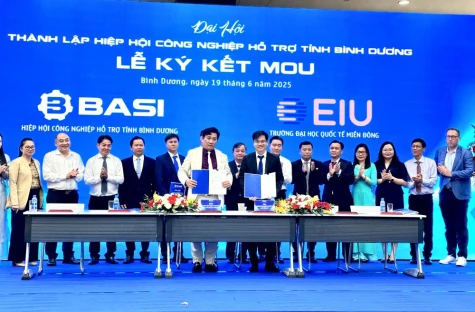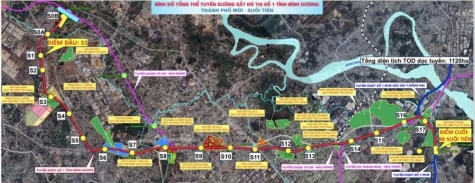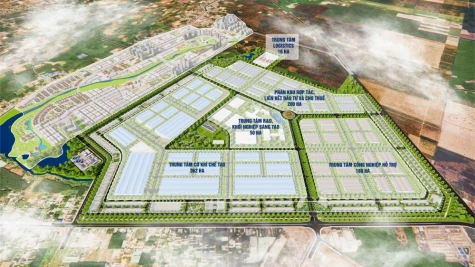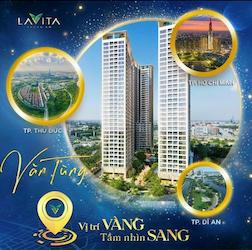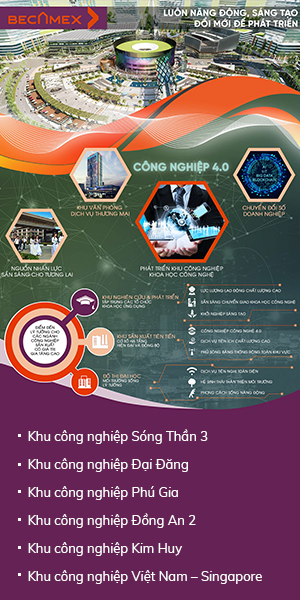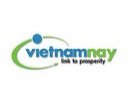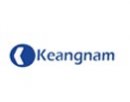
Multi-dimensional development
Recently, the advancement of trade and services has been oriented towards connectivity, fostering international partnerships to enhance the existing ecosystem and bridging the divide between industry and services within the province's economic framework. Binh Duong has placed significant emphasis on enhancing transport infrastructure to facilitate connections with Ho Chi Minh City, seaports, and international airports. Key initiatives, including the Ho Chi Minh City Vanh Dai 4 traversing the province, the Ho Chi Minh City - Thu Dau Mot - Chon Thanh Expressway, and Saigon River routes, are being expedited by Binh Duong to ensure their timely completion. The Bau Bang - Di An railway projects and the light rail transit (LRT) line linking urban development areas (TOD) are under meticulous study for submission to the Prime Minister for approval. Furthermore, urban beautification initiatives, improvements in water supply and drainage, tree planting, and the construction of standard schools are also prioritized within the province's infrastructure development plan.
Recently, during the 24th session, the Provincial People's Council reviewed and approved the Resolution committing resources to the implementation of Urban Railway Project No. 1 (Binh Duong New City - Suoi Tien, Ho Chi Minh City) with a total adjusted investment of VND 46,725 billion. This railway line spans over 29 kilometers, commencing at S1 station in the heart of Binh Duong New City and concluding at Suoi Tien Bus Station of Metro Line No. 1 in Ho Chi Minh City (Ben Thanh - Suoi Tien). The project route is designed to connect with Binh Duong station of the Ho Chi Minh City - Loc Ninh national railway line. It is anticipated that the project will establish a new electrified urban railway—a public transport system powered by electricity rather than diesel or steam engines—featuring double tracks, a 1,435mm gauge, and a design speed of 120 km/h, necessitating approximately 58 hectares of land. The Provincial People's Committee intends to proactively balance resources, comprising provincial budget capital of VND 16,725 billion (36%) and capital mobilized from Transit-Oriented Development (TOD) amounting to VND 30,000 billion (64%).
In the new phase of Binh Duong's sustainable development strategy, trade and services are recognized as pivotal sectors. Leveraging its advantageous geographical location and increasingly modernized transport infrastructure, Binh Duong is swiftly capitalizing on its potential for comprehensive development. The province is making substantial investments in modern infrastructure, aiming to transform into a smart city and a desirable place to live. |
In accordance with the planning, the Northern Binh Duong region will feature ten large-scale, modern commercial and service urban development projects located in An Tay ward, An Dien ward, and Phu An commune (Ben Cat city). The anticipated investment for these projects is approximately 130,327 billion VND. Notable projects include the Dong An Dien urban area, spanning 298 hectares with an estimated investment of around 17,880 billion VND; the Tay Phu An urban area project, covering 289.4 hectares with an estimated investment of about 13,167.7 billion VND; and the Dong An Tay urban area project and An Tay riverside urban area project, each occupying 289 hectares with an investment of approximately 13,150 billion VND. Additionally, the urban area project north of Ho Chi Minh City Vanh Dai 4 encompasses about 284 hectares, with an estimated investment of around 17,040 billion VND; the An Tay ecological urban area project spans 278 hectares with an investment of approximately 12,650 billion VND; the Tay An Tay urban area project covers 268 hectares with an estimated investment of about 12,194 billion VND; and the Northwest urban area project of Ho Chi Minh City Vanh Dai 4 occupies 254 hectares with an investment of approximately 11,557 billion VND.
In the northern region of Binh Duong, two projects are slated for implementation. The Tay An Dien urban area spans 188.4 hectares, with an investment capital of approximately VND 11,304 billion. Additionally, the Bac An Tay urban area project covers around 70 hectares, with an estimated investment capital of about VND 8,237 billion.
Unlock new opportunities
Experts assert that the Ho Chi Minh City - Binh Duong - Dong Nai - Ba Ria - Vung Tau Quadrilateral Region possesses the greatest economic development potential in the country. These localities are the primary contributors to the national budget. Such connectivity will establish a vital infrastructure axis for development. With robust infrastructure connections, the costs associated with importing and exporting goods will diminish, thereby enhancing economic efficiency across the entire region.

To leverage its infrastructural advantages, Binh Duong has concentrated on investing in dry ports and waterway ports, notably Binh Duong Port, Thanh Phuoc Port, and Ba Lua Port. Additionally, Binh Duong is planning to initiate the construction of two free trade zones in Di An City and Bau Bang District. These zones are intended to evolve into regional and international trade hubs, facilitating exports and offering logistics and financial services. Di An City has been capitalizing on its proximity to Ho Chi Minh City and its existing infrastructure to advance the logistics service industry. Furthermore, the growth rate of imports and exports in Binh Duong and the surrounding areas of the Southern Key Economic Zone is on the rise, prompting numerous businesses to select Di An City for customs procedures and the consolidation of import and export goods.
The head of the Department of Industry and Trade stated that the establishment of two free trade zones not only presents opportunities for import-export enterprises but also paves the way for new avenues in processing industries, supporting industries, financial services, and logistics in Binh Duong.
Mr. Pham Van Xo, Chairman of the Binh Duong Import-Export Association,stated that the functional departments of Binh Duong are actively implementing various solutions to facilitate the export of goods by promoting reforms, modernization, and the reduction of time and costs associated with customs clearance procedures. Businesses require support to enhance e-commerce initiatives and access export information channels to identify new markets. It is essential to closely monitor the conditions of each market to assess and pinpoint the types of goods that are in demand. Notably, the development of logistics infrastructure is currently one of the key projects that the business community is eagerly anticipating for investment. |
Reported by Tieu My – Anh Tuan – Translated by Vi Bao









